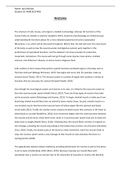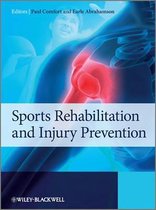Name: Iqra Ramzan
Student ID: RAM19127405
Anatomy
The structure of cells, tissues, and organs is studied in physiology, whereas the functions of the
human body are studied in anatomy (Langford, 2015). Anatomy and physiology are linked because
understanding the functions allows for a more detailed anatomical structure explanation
(BCcampus, n.d.), which will be discussed throughout. Before that, the talk will cover the many levels
of the body, as well as how the neuromuscular and digestive systems work together in the
performance of specialised functions, and the skeleton's structure provides for protection,
movement, and posture. The course will next go through nerve injuries, knee sprains, multiple
sclerosis, and Alzheimer's disease, as well as how to diagnose them.
Cells combine to form tissues that perform specific functions and build organs in the body such as
the brain and heart (Biology Dictionary, 2017). Neuroglia and nerve cells, for example, make up
nervous tissue (Tucker, 2015). The nervous system is a system of organs that conducts a variety of
functions that are necessary for survival (Verywell Health, 2020).
Even though the neurological system can function on its own, it is linked to the muscular system to
form the neuromuscular system (Health Direct, 2019). There are three types of muscles that make
up the muscular system (Palastanga and Soames, 2012). To begin, skeletal muscle is made up of non-
branching striated muscle fibres that are joined by loose areolar tissue. Second, smooth muscle is a
non-striated muscle that forms the muscular layer of hollow organs like the stomach and blood
vessel walls (2012). Finally, the cardiac muscle contains striated muscle that contracts in the heart to
allow blood to circulate (Healthline, 2018). Each movement begins with the communication between
the muscles and the brain, these three forms result in a neuromuscular system that acts to make the
body move as taught (Health Direct, 2019). Following that, the muscle fibres contract in response to
the message, activating the muscle and pulling on the tendon that connects it to the bone (Cleveland
Clinic, 2020). Finally, the tendon pulls on the bone to create movement, and if the muscle needs to
relax, the nervous system sends a new message to that muscle to relax and place the bone in a
resting position (2020).
The appendicular skeleton allows mobility by providing attachments for muscles to pull on the bones
to act as levers (Visible Body, 2021) (Rizzo, 2015). Because myocytes are muscle fibres with
specialised cells, a muscle can contract due to the interaction of myocytes in muscle cells (Kenhub,
, Name: Iqra Ramzan
Student ID: RAM19127405
2021). The elbow, for example, is a joint composed of the humerus, radius, and ulna that aids the
primary elbow joint in flexing and extending the arm. The forearm may also rotate and turn up and
down thanks to the radius and ulna (ShoulderDoc, 2021). The skeleton protects internal organs by
covering them to prevent harm (Visible Body, 2021). The thoracic cage, for example, protects the
lungs and heart, while the skull protects the brain and gives facial structure (2021).
Nerve injuries can develop if nerve cells (neurons) are injured in the nervous system, which
transmits messages between all parts of the body, including the spinal cord and the brain (Raleigh
Neurosurgical Clinic, n.d.). Pressure, strain, or a cut can all create this (American Society for Surgery
of the Hand, 2021). The latter keeps nerve signals from passing through a hole in the nerve.
Numbness is one of the most common signs of nerve injury, as it occurs when nerves that solely
send feelings are injured. Another symptom is weakness, which occurs when the nerves that
transport motor signals are injured, making it difficult to move without pain (2021).
Alzheimer's disease is another frequent condition, which is a brain ailment that causes memory loss
and makes daily tasks difficult to complete (Alzheimer's Association, 2021). Alzheimer's disease
develops when nerve cells in the brain lose their connections to one another as a result of proteins
forming plaques and tangles (Alzheimer's Society, n.d.). This injury takes place in the hippocampus, a
portion of the brain, where neurons gradually die and brain tissue shrinks (National Institute on
Aging, 2017). Despite the fact that little is known about what causes this condition, various factors
can raise the risk (NHS, 2018). For example, the risk of acquiring Alzheimer's disease doubles every
five years after age 65, and one in every three people aged 85 and older may get Alzheimer's disease
(National Institute on Aging, 2019).
Doctors utilise medical imaging such as Magnetic Resonance Imaging (MRI) or X-ray to show the
structures inside the knee to identify injuries like knee sprains (Sports-health, 2016). X-rays transfer
radiation through the body, whereas MRIs transmit radio waves through the body via magnets (John
Hopkins Medicine, 2021). Because it is difficult to see the damage on an X-ray, MRIs are more
appropriate for knee sprains.
To summarise, the body is made up of cells that form tissues and organs to execute various jobs. The
neuromuscular system is made up of three types of muscles that work together to move the body
according to instructions from the brain, whereas the digestive system is made up of organs that
work in a systematic manner from ingestion through excretion. The skeleton allows the body to





